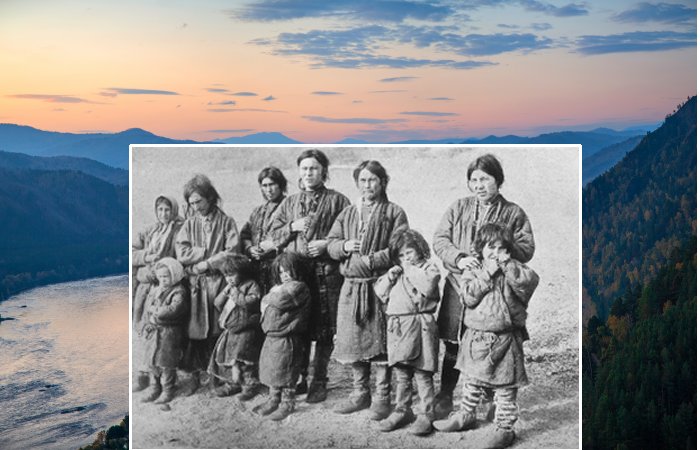Ellen Lloyd - AncientPages.com - Today, there are no more than 1,088 Ket people left. Only a few of them are Native speakers who master the Ket language. The rest speak Russian. The Ket people, who have their home in the Yenisei River basin, are the last nomadic hunter-gatherers of Siberia, a part of Asia that has been the home for millennia of various peoples and cultures.
Yenisei River in Siberia. Credit: Adobe Stock - Valerii
Indigenous people like the Ket and Khanty people were previously referred to as the Ostyak by the Imperial Russians.
Being descendants of fishermen and hunter tribes of the Yenisei taiga, the Kets originated from a region near the Altai Mountains or possibly somewhere near Lake Baikal. Considering the Ket people live in a remote part of Northern Russia, it is naturally challenging to learn as much as we would like about their history, traditions, and culture.
The Ket Language Is Unique And Almost Extinct
The Ket language "lacks apparent affiliation with any major language family and is clearly distinct from surrounding Uralic, Turkic and Tungusic languages." 1 Unfortunately, the language is slowly dying and may soon be extinct. According to Dr. Edward Vadja, Department of Linguistics of Kentucky University, the Ket people "are ancestral to the Na-Dene and Athabaskan people in the Americas." 2 Dr. Vadja is one of the few who have had the privilege to visit, live among the Ket, and study them.
Photo of the Ket people taken in 1913. Credit: Fridtjof Nansen - National Library of Norway - Public Domain
The Ket language does not resemble any other language in Siberia. Over the centuries, the Kets have been forced to relocate several times, leading to their language and culture loss. "First, they were under a constant pressure from the reindeer herders to the north (Enets and Nenets) and east (Evenks) and the Turkic-speaking pastoralists to the south. Second, Russian conquest of Siberia, which started at the end of the 16th century, exposed the natives to new diseases, such as the 17th century smallpox epidemic. Third, in the 20th century USSR resettled the Kets in Russian-style villages, thus interrupting their nomadic lifestyle." 1
The Kets tried to resist and hold on to their roots, but being a small ethnic group made it difficult, and they had to adopt the same lifestyle as ethnic Russians. Nevertheless, despite it all, the Kets did manage to save their rich and colorful culture.
The Kets And Shamanism
Shamanism, "a nature-based, animistic religion centred around a spiritual relationship between the inner life of human beings and a physical world imbued with its own spirits, had long been practised in a variety of forms by the peoples of Siberia." 3
"Not surprisingly, attempts by arriving Russians to convert indigenes to Orthodoxy coincided with moves to stamp out shamanism, and in the 1920s Soviet authorities officially banned shamanism. The Soviet authorities made it illegal to perform the rituals in public and often they confiscated paraphernalia such as the drums and coats. One problem faced by authorities, however, was that even tribal people who were officially “good socialists” continued to believe in shamanism.
Depiction of Universe on a shaman's drum. Credit: Adobe Stock - Af Juulijs
Shamanism penetrated virtually all aspects of life for the indigenes, and quite clearly this was not going to change simply by banning it or disseminating Soviet propaganda. Measures, therefore had limited impact, and it was only when the lifestyle itself faced a serious challenge through collectivization and the forced settlement of nomads in the 1930s that shamanism began to seriously become undermined. Although many aspects of shamanism continue to exist in indigenous culture today, it tends to survive in a fragmented form or take a revived form, generally known as neo-shamanism," J. Haywood writes in the book Siberia: A Cultural History.
Some of the Ket people did not change their religious beliefs and continued practicing shamanism. Among the Kets, one can encounter several types of shamans. Some are healers, while others specialize in sacral rites, for example.
"Kets see the eagle as the shaman’s most important helping spirit in rituals. In their rituals the Koryak shamans of the north-east frequently work with wolves and eagles as well as bears. A shaman in Tuva will imitate the cry of a wolf if he or she wishes to frighten people." 3
What Does DNA Reveal About The Ket People?
When six Ket individuals were genotyped and two of them sequenced, scientists concluded "the Kets do not differ from surrounding Siberian populations, a rather surprising finding, given their unique language and ancient hunter-gatherer life-style." 1
This seemed rather odd, and new DNA studies were launched. This time, researchers "collected 57 (46 unrelated) samples of Kets and 42 unrelated samples of their neighboring Uralic-speaking ethnic groups (Nganasans inhabiting the Taymyr Peninsula and Enets and Selkups living further south along Yenisei)." 1
Men and children of the Ket people. Credit: Fridtjof Nansen - National Library of Norway - Public Domain
"We genotyped approximately 130,000 autosomal SNPs and determined mitochondrial and Y-chromosomal haplogroups with the GenoChip array. We also performed high-coverage genome sequencing of two Ket individuals. Using these data, we investigated connections between Kets and modern and ancient Siberian and North American populations (including the Mal’ta and Saqqaq ancient genomes). In addition, we estimated Neanderthal contribution in Kets’ genome and in specific gene groups," the research team wrote in their study. 1
The results of this new study were different and showed Ket people share "the genetics, haplogroup Q and a common ancestral language with Native American people along with other similarities." 2
According to Dr. Vadja, there is a relationship between the Ket language and the Na-Dene languages, of which Navajo is the most noticeable and widespread.
Though the Ket people have been studied, we must not forget there are few individuals left, and they are the oldest inhabitants of northern Asia. Let us hope the history, culture, and traditions of the remarkable Ket people will be preserved for future generations, and hopefully, their unique language will not die out.
Written by Ellen Lloyd – AncientPages.com
Copyright © AncientPages.com All rights reserved. This material may not be published, broadcast, rewritten or redistributed in whole or part without the express written permission of AncientPages.com
Expand for references- Flegontov, P., Changmai, P., Zidkova, A. et al. Genomic study of the Ket: a Paleo-Eskimo-related ethnic group with significant ancient North Eurasian ancestry. Sci Rep 6, 20768 (2016). https://doi.org/10.1038/srep20768
- Native Heritage Project - The Ket People of North Asia – Ancestors of Native Americans
- J. Haywood - Siberia: A Cultural History








